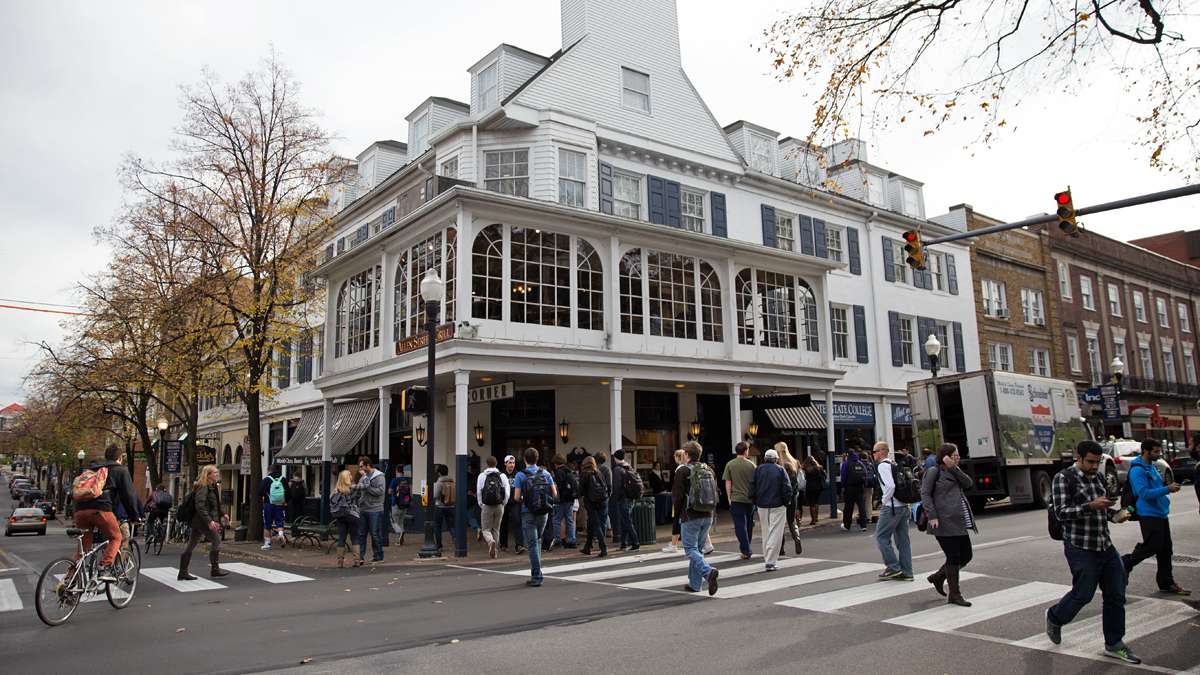Pa.’s college towns capitalize on the knowledge economy
Listen
Pedestrians cross in front of The Corner Room at the intersection of College Avenue and S. Allen Street steps away from Penn State campus. (Lindsay Lazarski/WHYY)
Pittsburgh and State College take different approaches to appeal to students and private industry alike.
Walk around Videon’s headquarters, and it’s easy to forget that you’re in a short, squat building in the back of an office park. Dogs run around the open workspace, filled with standing desks, funky stone tables and huge computer monitors.
They’re an audiovisual technology company, so it make sense that they would want to show off their equipment.
“We’ve got a really nice little theater area here, which is a fun place to show off the high tech stuff that we do,” says marketing director Rebecca Lundin. “And also, bring our kids in and have birthday parties.”
The leather recliners and huge movie screen aren’t even the coolest part of the office. Try a game room, with foosball, pinball and a kegerator.
Videon’s offices, and technology, scream Silicon Valley. But their zip code says State College, a university town far from highway intersections, railroads or even a river.
“Older cities, they would locate on the river, and the river would power the paddle wheel, and the paddle wheel would make the electricty, and off went the factories,” says Videon CEO Todd Erdley.
It’s 2015. His company doesn’t need a paddle wheel or a factory.
“Our river is talent. Our river is intellectual capital coming from Penn State,” said Erdley.
Erdley isn’t the only person thinking this way. In the modern knowledge economy, communities near research universities are capitalizing on their value. In Pennsylvania, that means State College is thinking about how to grow, and how to appeal to people outside the 18-22 age bubble. And Pittsburgh is hoping to broaden the college culture around Carnegie Mellon and the University of Pittsburgh.
There, at least, they have a size advantage.
“The University of Pittsburgh had as many students when the city was twice the size that it is now,” says David Miller of the Center for Metropolitan Studies.
People affiliated with the universities make up a larger percentage of the population than ever before, giving Pittsburgh some of that college town feel — and the add on benefits like higher education levels, more job opportunities and a bigger arts and culture scene. That’s starting to pay off.
“More of those students and those younger individuals are selecting to stay in Pittsburgh,” says Miller. “And much of that retention is because there are available jobs, many of which are generated by the ed and med sector.”
These add-on benefits are what make college towns appealing to professionals, according to Scott Shapiro, an aide in the mayor’s office in Lexington, Kentucky. Shapiro was researching cities that resembled Lexington, home of the University of Kentucky and an IBM office, when he discovered a trend: college towns that have expanded to the size of cities, thanks to private industry investment. He calls them, “University Cities.”
Shapiro has identified seven university cities in the country, including Ann Arbor, home of the University of Michigan and a Google office, and Lincoln, with the University of Nebraska and the center of the so-called “Silicon Prairie.” (The others are Chapel Hill/Durham, North Carolina, Fort Collins, Colorado and Madison, Wisconsin.)
There are a lot of people who think the time is right for State College to join that list. There’s an increased interest in private industry and the borough is starting to lay the groundwork to attract a big company, by providing high speed internet and office space. But there are some very Pennsylvania challenges that State College faces.
“The Centre region is actually five townships and the borough,” says Courtney Hardin, communications manager for the borough government. “The townships that are surrounding us have been very clear on the fact that they want to protect farmland, so if we’re going to grow, it’s going to be probably in height or density.”
For State College to become a true university city, there would need to be some big conversations, like vision for the town and relationship to the university. And countless small conversations as well. Like, where to put the kegerator.
WHYY is your source for fact-based, in-depth journalism and information. As a nonprofit organization, we rely on financial support from readers like you. Please give today.


